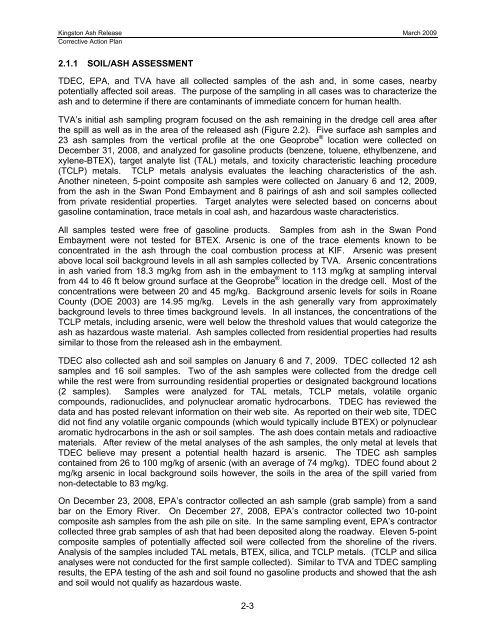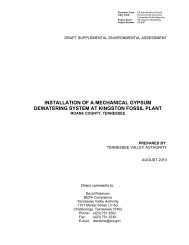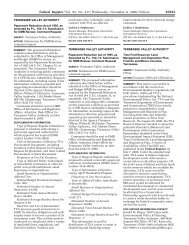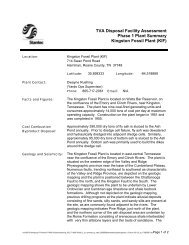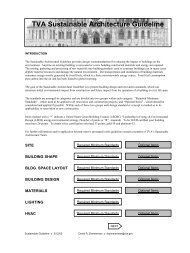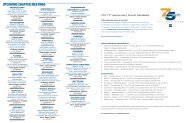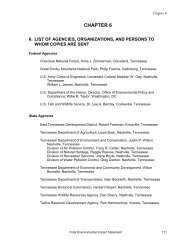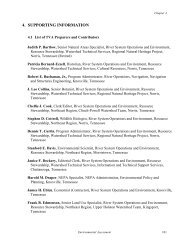Corrective Action Plan - Tennessee Valley Authority
Corrective Action Plan - Tennessee Valley Authority
Corrective Action Plan - Tennessee Valley Authority
Create successful ePaper yourself
Turn your PDF publications into a flip-book with our unique Google optimized e-Paper software.
Kingston Ash Release March 2009<br />
<strong>Corrective</strong> <strong>Action</strong> <strong>Plan</strong><br />
2.1.1 SOIL/ASH ASSESSMENT<br />
TDEC, EPA, and TVA have all collected samples of the ash and, in some cases, nearby<br />
potentially affected soil areas. The purpose of the sampling in all cases was to characterize the<br />
ash and to determine if there are contaminants of immediate concern for human health.<br />
TVA’s initial ash sampling program focused on the ash remaining in the dredge cell area after<br />
the spill as well as in the area of the released ash (Figure 2.2). Five surface ash samples and<br />
23 ash samples from the vertical profile at the one Geoprobe ® location were collected on<br />
December 31, 2008, and analyzed for gasoline products (benzene, toluene, ethylbenzene, and<br />
xylene-BTEX), target analyte list (TAL) metals, and toxicity characteristic leaching procedure<br />
(TCLP) metals. TCLP metals analysis evaluates the leaching characteristics of the ash.<br />
Another nineteen, 5-point composite ash samples were collected on January 6 and 12, 2009,<br />
from the ash in the Swan Pond Embayment and 8 pairings of ash and soil samples collected<br />
from private residential properties. Target analytes were selected based on concerns about<br />
gasoline contamination, trace metals in coal ash, and hazardous waste characteristics.<br />
All samples tested were free of gasoline products. Samples from ash in the Swan Pond<br />
Embayment were not tested for BTEX. Arsenic is one of the trace elements known to be<br />
concentrated in the ash through the coal combustion process at KIF. Arsenic was present<br />
above local soil background levels in all ash samples collected by TVA. Arsenic concentrations<br />
in ash varied from 18.3 mg/kg from ash in the embayment to 113 mg/kg at sampling interval<br />
from 44 to 46 ft below ground surface at the Geoprobe ® location in the dredge cell. Most of the<br />
concentrations were between 20 and 45 mg/kg. Background arsenic levels for soils in Roane<br />
County (DOE 2003) are 14.95 mg/kg. Levels in the ash generally vary from approximately<br />
background levels to three times background levels. In all instances, the concentrations of the<br />
TCLP metals, including arsenic, were well below the threshold values that would categorize the<br />
ash as hazardous waste material. Ash samples collected from residential properties had results<br />
similar to those from the released ash in the embayment.<br />
TDEC also collected ash and soil samples on January 6 and 7, 2009. TDEC collected 12 ash<br />
samples and 16 soil samples. Two of the ash samples were collected from the dredge cell<br />
while the rest were from surrounding residential properties or designated background locations<br />
(2 samples). Samples were analyzed for TAL metals, TCLP metals, volatile organic<br />
compounds, radionuclides, and polynuclear aromatic hydrocarbons. TDEC has reviewed the<br />
data and has posted relevant information on their web site. As reported on their web site, TDEC<br />
did not find any volatile organic compounds (which would typically include BTEX) or polynuclear<br />
aromatic hydrocarbons in the ash or soil samples. The ash does contain metals and radioactive<br />
materials. After review of the metal analyses of the ash samples, the only metal at levels that<br />
TDEC believe may present a potential health hazard is arsenic. The TDEC ash samples<br />
contained from 26 to 100 mg/kg of arsenic (with an average of 74 mg/kg). TDEC found about 2<br />
mg/kg arsenic in local background soils however, the soils in the area of the spill varied from<br />
non-detectable to 83 mg/kg.<br />
On December 23, 2008, EPA’s contractor collected an ash sample (grab sample) from a sand<br />
bar on the Emory River. On December 27, 2008, EPA’s contractor collected two 10-point<br />
composite ash samples from the ash pile on site. In the same sampling event, EPA’s contractor<br />
collected three grab samples of ash that had been deposited along the roadway. Eleven 5-point<br />
composite samples of potentially affected soil were collected from the shoreline of the rivers.<br />
Analysis of the samples included TAL metals, BTEX, silica, and TCLP metals. (TCLP and silica<br />
analyses were not conducted for the first sample collected). Similar to TVA and TDEC sampling<br />
results, the EPA testing of the ash and soil found no gasoline products and showed that the ash<br />
and soil would not qualify as hazardous waste.<br />
2-3


